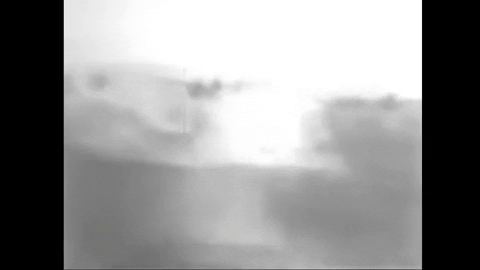Lightnings, Mosquitoes, Thunderbolts, Mustangs, Warhawks, Oh My!
 |
| "Rendova Island Invasion, June 30, 1943. Landing craft debouch U.S. amphibious troops who run for the trees. Overhead a USAAF P-40 provides air coverage." Naval History and Heritage Command 80-G-52671. |
Fighters play many roles beyond air superiority. As shown in the photo above of the invasion of Rendova (Operation Toenail) on 30 June 1942, one of their important roles was strafing enemy targets during World War II.
 |
| Captain A.F. Eaton of 84th Squadron, VIII Air Force, strafes a Luftwaffe bomber parked on the airfield, 19 July 1944. |
Strafing runs were a common feature of both sides during World War II. Sometimes escort fighters would strafe targets after a bombing run, other times it was a planned operation to disrupt ground supply. And, at times, it was just a way for fighter pilots to kill some boredom during long patrols through empty skies.
We start off with fighters strafing a Tiger tank that is on the move during the day in the European Theater of Operations. While bullets often bounced harmlessly off of tank armor, you might get lucky and hit something explosive.
Next, we turn to some strafing runs against trains and fast-moving vehicles in Occupied Europe. It became very dangerous for Germans to drive during the day. In fact, German General Erwin Rommel was badly wounded when he tried this about a week after D-Day in June 1944. His driver, a war hero during the Norwegian campaign, was killed and he was in the hospital for some time.
US Navy planes flew many strafing runs in support of island invasions in the Pacific Theater of Operations. Here, fighters strafe targets on Okinawa during the invasion of April 1945.
US Air Force fighter bombers fired rockets at ground targets during the final year of the war. Here, some fire at Japanese resistance on Okinawa in 1945.
Returning to the ETO, the US Army Air Force spent weeks attacking ground targets prior to D-Day, 6 June 1944, in order to seal off the beachhead area and starve it of supplies. Here, fighters strafe a Luftwaffe airfield.
The campaign up the boot of Italy in 1943-45 was a long, hard slog. The Germans occupied a series of mountain defensive positions that were very strong. They held out for six months on the "Winter Line," a position anchored on the monastery at Monte Cassino. Finally, the Allies succeeded in dislodging them in May 1944 after destroying their supply lines from northern Italy. This was Operation Strangle. Here, Republic P-47 Thunderbolts attack an Italian supply train.
Above is another view of USAAF fighters strafing German ground targets. Sometimes, the pilots would get lucky and hit a fuel storage tank or something similar that would blow up in a huge explosion.
Above, Allied P-38 Lightning fighters strafe German trains. The Germans learned to fear the P-38, which they called the "fork-tailed devil" due to its distinctive appearance with two booms. These kinds of attacks led to the "German glance," which was a worried look back over your shoulder in case an Allied fighter was approaching.
Throughout 1945, the USAAF launched a series of bombing raids on Tokyo. The P-51 Mustang escort fighters would guard the bombers, but once the mission was done, the pilots could choose ground targets at will to liven up the day. Here, they strafe Japanese shipping near Tokyo.
In 1944, the RAF launched a series of raids against German naval shipping that was hiding out in Norwegian fjords. These were difficult missions because the Germans had a lot of defensive artillery that could throw up a lot of flak, and the harbors were surrounded by mountain peaks that required swooping actions and quick pull-up to avoid crashing into the hills. Here, de Havilland Mosquito bombers attack a Kriegsmarine ship in a Norwegian fjord during the summer of 1944.
 |
| Strafing by fighters was often more effective against shipping than using level bombers. Even though they were only firing machine guns, they were much, much more accurate. |
2021
No comments:
Post a Comment